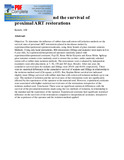| dc.description.abstract | Objective: To determine the influence of rubber dam and cotton roll isolation methods on the survival rates of proximal ART restorations placed in deciduous molars by experienced/inexperienced operators/assistants, using three brands of glass ionomer cements.
Methods: Using only hand instruments, 804 restorations (fillings and sealants) were made in 6 to 8 year-olds, by experienced/inexperienced operators randomly paired with experienced/inexperienced assistants. Fuji IX, Ketac Molar Easymix and Ketac Molar Aplicap glass ionomer cements were randomly used to restore the cavities, under randomly selected cotton roll or rubber dam isolation methods. The restorations were evaluated by independent examiners soon after placement, at 7, 30, 150 and 365 days.
Results: After one year, the cumulative survival rates for sealants and fillings were 29.6% and 44.8% respectively. There were no statistical differences in the cumulative survival of sealants and fillings in relationship to the isolation method used (Chi-square, p<0.05). But, Kaplan-Meier survival test indicated slightly more fillings survived with rubber dam than with cotton roll isolation methods up to one year. The method of isolation and the survival rates of the restorations were not significantly affected by the experiences of the operator or the material used. However, experienced assistants were associated with higher statistical survival rates of the restorations irrespective of the isolation method used.
Conclusion: There were no significant statistical differences with the survival of the proximal restorations made using the two methods of isolation, in relationship to the material and the experience of the operator. Experienced assistants had significant statistical influence on the survivals of the restorations compared to inexperienced assistants, irrespective of the experience of the operator and the isolation method applied | en |

